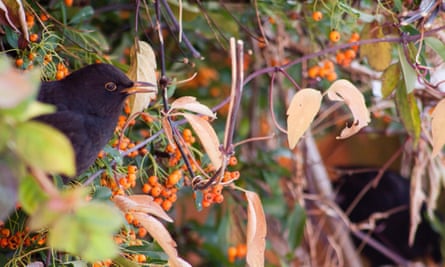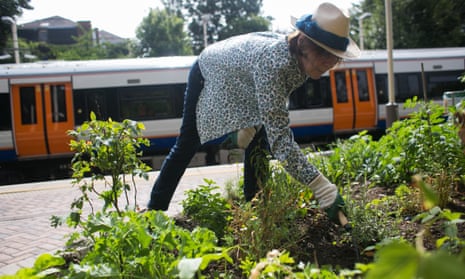Rewilding excites people with its images of wolves and ambition to return entire landscapes to nature as humans withdraw after centuries of domination. But the grandeur of rewilding can also make the concept seem remote or irrelevant to people living ever more urban lives.
To declare we are rewilding our garden, or window box, is probably a contradiction in terms and risks cheapening this important conservation concept. But there are principles of rewilding – stepping back and allowing natural processes to occur, and encouraging wild plants and insects – which we can all embrace. The most relevant rewilding idea for us urban beings? Let go, and reduce our micromanagement of whatever small patch of earth we own, rent or enjoy and influence.
1. Rewild ourselves
The first step is to change our way of seeing. I’ve struggled with “weedy” patios and “rank” lawns for a few years but I now see “tidy” gardens as they are for every other living species: desolate and hostile, stripped of the natural abundance and vigour that our soils and climate naturally serve up, even in the heart of a city.
2. Discard all pesticides, weedkillers, slug pellets and fertilisers
We’re persuaded to apply far too many chemicals to our gardens and these are killing the insects upon which human life ultimately depends.
3. Decorate concrete
For those of us lucky enough to have a garden, we may well have a front garden which is now concrete, shingle or tarmac. The number of front gardens totally paved over has tripled from 1.5m to 4.59m between 2005 and 2015, according to the Royal Horticultural Society. A London survey found that the capital is losing the equivalent of two-and-a-half Hyde Parks of greenery a year from its domestic gardens – about 3,000 hectares (7,410 acres).
Even if your front garden still needs to house a car, there is space for unruly nature. Plant a native hedge (young hazel, field maple, hawthorn and other “whips” can cost as little as 30p each from good nurseries) or squeeze insect-friendly flowers such as Verbena borariensis, buddleia or English lavender onto your gravel. Think vertical in small concrete spaces: our native ivy (Hedera helix) is a superb wildlife host – a source of food for birds and insects, shelter for nests and a food plant for holly blue butterfly caterpillars.
4. Pondlife
Just as water sustains life on earth, the single best thing for biodiversity in a small space is to add water. And you don’t need much space for a pond. A washing-up bowl will do. I created a 50cm x 90cm pond, and collected some duckweed and other common pond “weeds” from a friend’s pond. Within a year, it was found by mating frogs, newts, pond snails and damselflies.
5. Rewild our lawn
The trend for wildflower meadows leads to substituting lawns for sowing a meadow of flowering annuals which looks great for a summer and then dies away. It’s often better to simply stop mowing. If lawns are old and not weedkillered to death, they are full of different species of grass and herbs, many of which “flower” as beautifully as flowers. I still have neatly mown paths and borders around my long grass. Orchid-lovers like to cut their “meadows” in July but I leave mine until November – late seeds are food for goldfinches and a high autumnal cut doesn’t kill the butterflies such as meadow browns whose caterpillars have fed up on grass and are safely hibernating in the turf.

6. Don’t over-plant
In an era of garden makeovers, we seek instant transformations. When we want a “wild” garden we buy wild flower seeds or wild plug plants or expensive “native” perennials. But how about standing back for a year? Wild nature needs space and time but responds far faster than we expect. Do nothing but watch your garden and you’ll be amazed by what pops up. A friend living on a modern housing estate in Leicester had orchids appear in his lawn as soon as he let it get a bit overgrown. My newly unkempt lawn suddenly sprouted oak trees (acorns buried by jays), hawthorn, holly, hazel and a profusion of oxeye daisies, clover and even cuckooflower. The things that find their way into your plot naturally are likely to be well-suited to your soil, and more likely to thrive than introduced species. The more vigorous arrivals – such as bindweed, bramble and nettle – may have to be managed so they don’t swamp everything else, which is contrary to rewilding ideals. But then some bramble and nettle is superbly useful for hundreds of birds and insects. Even thistles are food for a variety of moth caterpillars and the caterpillars of the painted lady butterfly.
7. Relax our gardening – and our ideas about native and non-native
Cut hedges less. Let dandelions flower and seed. Allow a few poppies to flower between vegetables. It’s hard for keen gardeners to relax. We also learn “native good, non-native bad”. While we should use native wild flower mixes (rather than cheaper generic mixes which contain non-native species), we cannot turn back the clock and cities are full of non-native plants. Laurel hedging is terrible for nature, as is leylandii, but there are plenty of insect-friendly non-native flowers and shrubs, from buddleia to cotoneaster.

8. Rattle our grass
Yellow rattle is a pretty little yellow flower which is parasitic on grass. It’s difficult to establish because seeds need to be really fresh but I obtained some from my father and scattered them on my lawn. (If you don’t have a yellow rattle-growing parent, try a reputable wild flower nursery.) Each July, I scatter the fresh seeds and the yellow rattle is booming. Grass is great but often too vigorous for other wild flowers to thrive. Yellow rattle creates the space for less robust flowering plants to thrive. It’s the cornerstone of a vibrant perennial wildflower meadow.
9. Space for nature
We may only have a window box but there is always space for nature. We can cram dozens of wildflowers onto a window sill. Do we have a wall on which we can erect a birdbox? A roof for a swift box? (South-facing is usually too hot for breeding birds.) Or any outside wall-space for bug hotels?

10. Encourage wildness around us
Those of us without gardens can still shape our green spaces. Get guerrilla planting. Talk to neighbours with gardens. Persuade local schools or hospitals or industrial estates to leave some patches of long grass – or our local councils. In an era of austerity, we’re pushing at an open door. Many local authorities are discovering that allowing roadside verges, roundabouts, hedgerows or parkland to become wilder can save money. Burnley borough council estimates it saves £58,000 per year by reducing grass-cutting to benefit wildlife. It’s also popular with voters: a Friends of the Earth survey found that 81% of the public support plans to cut roadside verges and parkland less often to help wild flowers and bees. Dorset, Devon, Cornwall, East Sussex and Bristol are among councils to have adopted “pollinator action plans”.
11. Be surprised
In the course of writing this, my six-year-old daughter barged into my study. It was important: she was carrying a stunning eyed hawkmoth. She’d found it in a patch of sallow – a scrubby “weed” of a bush. I planted a thicket of sallows (29p each) three years ago. They are the foodplant for dozens of insects, including moths and butterflies, and the eyed hawkmoth was almost certainly laying eggs on them. If you embrace a teeny bit of wild, wild nature will embrace you.

Comments (…)
Sign in or create your Guardian account to join the discussion